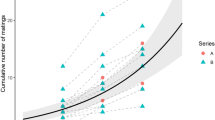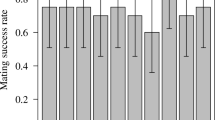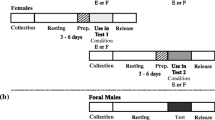Abstract
In many animals, males increase their reproductive success by mating with as many females as possible. The number of females a male can fertilize is often limited by male competition for access to females, sperm competition, and the cost of sperm production. Especially, recent studies have shown that sperm production is more costly than previously expected. In the two-spotted spider mite, Tetranychus urticae Koch, the number of females a male can inseminate is limited mainly by male competition for access to females. However, in the absence of rivals, males mate with so many females that they can become sperm-depleted. Mating without sperm transfer does not produce any offspring, although it takes time and energy. Therefore, a question arises as to why males continue to mate even after sperm depletion. In this study, we hypothesized that males continue to mate because sperm is replenished after a short period. To test the hypothesis, we investigated how long it takes for sperm replenishment after sperm depletion. We found that in 3 h, sperm can be replenished enough to inseminate a few females. As 3 h is sufficiently short not to lose the next mating opportunity, the results support the hypothesis. However, copulation duration in the sperm-replenished males was significantly longer than in the sperm-depleted males but shorter than in males before sperm depletion. To explain the differences, further research would be necessary. In addition, anatomical physiology study in males is also required to confirm that sperm is indeed depleted and replenished.



Similar content being viewed by others
Data Availability
The datasets generated during and/or analysed during the current study are available from the supplementary information.
References
Abe J (2019) Sperm-limited males continue to mate, but females cannot detect the male state in a parasitoid wasp. Behav Ecol Sociobiol 73:52. https://doi.org/10.1007/s00265-019-2653-4
Aron S, Lybaert P, Baudoux C, Vandervelden M, Fournier D (2015) Sperm production characteristics vary with level of sperm competition in Cataglyphis desert ants. Funct Ecol 30:614–624
Bateman AJ (1948) Intra-sexual selection in Drosophila. Heredity 2:349–368. https://doi.org/10.1038/hdy.1948.21
Boudreaux HB (1963) Biological aspects of some phytophagous mites. Ann Rev Entomol 8:137–154. https://doi.org/10.1146/annurev.en.08.010163.001033
Brooks ME, Kristensen K, van Benthem KJ et al (2017) glmmTMB: balances speed and flexibility among packages for zero-inflated generalized linear mixed modeling. R J 9:378–400
Chargé R, Wedell N, Lindstedt C et al (2016) Variation in male fertility in a polymorphic moth, Parasemia plantaginis. Anim Behav 111:33–40. https://doi.org/10.1016/j.anbehav.2015.10.014
Damiens D, Boivin G (2006) Why do sperm-depleted parasitoid males continue to mate? Behav Ecol 17:138–143. https://doi.org/10.1093/beheco/arj009
Dowling DK, Simmons LW (2012) Ejaculate economics: testing the effects of male sexual history on the trade-off between sperm and immune function in australian crickets. PLoS ONE 7:e30172. https://doi.org/10.1371/journal.pone.0030172
Gordh G, DeBach P (1976) Male inseminative potential in Aphytis lingnanensis (Hymenoptera: Aphelinidae). Can Entomol 108:583–589. https://doi.org/10.4039/Ent108583-6
Helle W (1967) Fertilization in the two-spotted spider mite (Tetranychus urticae: Acari). Entomol Exp Appl 10:103–110. https://doi.org/10.1111/j.1570-7458.1967.tb00049.x
Helle W, Sabelis MW (1985) Spider mites: their Biology, Natural Enemies and Control. Vol.1A. Elsevier
Kobayashi H, Sato Y, Egas M (2022) Males mate with females even after sperm depletion in the two-spotted spider mite. Exp Appl Acarol 86:465–477. https://doi.org/10.1007/s10493-022-00706-x
Laing JE (1969) Life history and life table of Tetranychus urticae. Acarologia 11:32–42
Laing DR, Caltagirone LE (1969) Biology of Habrobracon lineatellae. Can Entomol 101:135–142. Hymenoptera: Braconidaehttps://doi.org/10.4039/Ent101135-2
Lemaître J-F, Rigaud T, Cornet S, Bollache L (2009) Sperm depletion, male mating behaviour and reproductive ‘time-out’ in Gammarus pulex. Amphipoda) Anim Behav 77:49–54. https://doi.org/10.1016/j.anbehav.2008.08.028. Crustacea
Macartney EL, Zeender V, Meena A et al (2021) Sperm depletion in relation to developmental nutrition and genotype in Drosophila melanogaster. Evolution 75:2830–2841. https://doi.org/10.1111/evo.14373
Macke E, Magalha ̃es S, Khanh HD-T, Frantz A, Facon B, Olivieri I (2012) Mating modifies female life history in a haploid spider mite. Am Nat 179:147–162
Michalik P, Rittschof CC (2011) A comparative analysis of the morphology and evolution of permanent sperm depletion in spiders. PLoS ONE 6:e16014
Morita A, Ullah MS, Sera T, Gotoh T (2020) Effectiveness of second mating in sperm-depleted females in the two-spotted spider mite, Tetranychus urticae (Acari: Tetranychidae). Systematic and Applied Acarology 1561-1575-1561–1575. https://doi.org/10.11158/saa.25.9.4
Nadel H, Luck RF (1985) Span of female emergence and male sperm depletion in the female-biased, quasi-gregarious parasitoid, Pachycrepoideus vindemiae (Hymenoptera: Pteromalidae. Ann Entomol Soc Am 78:410–414. https://doi.org/10.1093/aesa/78.3.410
Oku K (2010) Males of the two-spotted spider mite attempt to copulate with mated females: effects of double mating on fitness of either sex. Exp Appl Acarol 50:107–113
Olsson M, Madsen T, Shine R (1997) Is sperm really so cheap? Costs of reproduction in male adders, Vipera berus. Proc Biol Sci 264:455–459. https://doi.org/10.1098/rspb.1997.0065
Partridge L, Harvey PH (1992) What the sperm count costs. Nature 360:415–415. https://doi.org/10.1038/360415a0
Pitnick S, Markow TA (1994a) Large-male advantages associated with costs of sperm production in Drosophila hydei, a species with giant sperm. Proc Natl Acad Sci USA 91:9277–9281. https://doi.org/10.1073/pnas.91.20.9277
Pitnick S, Markow TA (1994b) Male gametic strategies: sperm size, testes size, and the allocation of ejaculate among successive mates by the sperm-limited fly Drosophila pachea and its relatives. Am Nat 143:785–819
Pitnick S, Markow TA, Spicer GS (1995) Delayed male maturity is a cost of producing large sperm in Drosophila. Proc Natl Acad Sci 92:10614–10618. https://doi.org/10.1073/pnas.92.23.10614
Potter DA, Wrensch DL (1978) Interrupted matings and the effectiveness of second inseminations in the twospotted spider mite. Ann Entomol Soc Am 71:882–885. https://doi.org/10.1093/aesa/71.6.882
Potter DA, Wrensch DL, Johnston DE (1976a) Guarding, aggressive behavior, and mating success in male twospotted spider mites. Ann Entomol Soc Am 69:707–711. https://doi.org/10.1093/aesa/69.4.707
Potter DA, Wrensch DL, Johnston DE (1976b) Aggression and mating success in male spider mites. Science 193:160–161. https://doi.org/10.1126/science.193.4248.160
Preston BT, Stevenson IR, Pemberton JM, Wilson K (2001) Dominant rams lose out by sperm depletion. Nature 409:681–682. https://doi.org/10.1038/35055617
R Core Team (2022) R: a language and environment for statistical computing. R Foundation for Statistical Computing, Vienna, Austria
Radhakrishnan P, Pérez-Staples D, Weldon CW, Taylor PW (2009) Multiple mating and sperm depletion in male Queensland fruit flies: effects on female remating behaviour. Anim Behav 78:839–846. https://doi.org/10.1016/j.anbehav.2009.07.002
Ramadan MM, Wong TTY, Wong MA (1991) Influence of parasitoid size and age on male mating success of opiinae (Hymenoptera:Braconidae), larval parasitoids of fruit flies (Diptera:Tephritidae). Biol Control 1:248–255. https://doi.org/10.1016/1049-9644(91)90074-A
Rittschof C, Hilber S, Tudor M, St. Mary C (2012) Modeling male reproductive strategies and optimal mate number in an orb-web spider. Behav Ecol 23:1–10. https://doi.org/10.1093/beheco/arr142
Rodrigues LR, Figueiredo ART, Varela SAM et al (2017) Male spider mites use chemical cues, but not the female mating interval, to choose between mates. Exp Appl Acarol 71:1–13
Rodrigues LR, Figueiredo ART, van Leeuwen T et al (2020) Costs and benefits of multiple mating in a species with first-male sperm precedence. J Anim Ecol 89:1045–1054. https://doi.org/10.1111/1365-2656.13171
Rubolini D, Galeotti P, Pupin F et al (2007) Repeated matings and sperm depletion in the freshwater crayfish Austropotamobius italicus. Freshw Biol 52:1898–1906. https://doi.org/10.1111/j.1365-2427.2007.01814.x
Saito Y (1995) Sociobiological aspects of spider mite life types. J Acarological Soc Japan 4:55–67. https://doi.org/10.2300/acari.4.55
Sato Y, Sabelis MW, Egas M, Faraji F (2013) Alternative phenotypes of male mating behaviour in the two-spotted spider mite. Exp Appl Acarol 61:31–41. https://doi.org/10.1007/s10493-013-9673-y
Sato Y, Sabelis MW, Egas M (2014) Alternative male mating behaviour in the two-spotted spider mite: dependence on age and density. Anim Behav 92:125–131. https://doi.org/10.1016/j.anbehav.2014.03.032
Sato Y, Rühr PT, Schmitz H et al (2016) Age-dependent male mating tactics in a spider mite—A life‐history perspective. Ecol Evol 6:7367–7374. https://doi.org/10.1002/ece3.2489
Satoh Y, Yano S, Takafuji A (2001) Mating strategy of spider mite, Tetranychus urticae (Acari: Tetranychidae) males: postcopulatory guarding to assure paternity. Appl Entomol Zool 36:41–45. https://doi.org/10.1303/aez.2001.41
Schausberger P, Sato Y (2019) Parental effects of male alternative reproductive tactics (ARTs) on ARTs of haploid sons. Funct Ecol 33:1684–1694. https://doi.org/10.1111/1365-2435.13385
Schausberger P, Sato Y (2020) Kin-mediated male choice and alternative reproductive tactics in spider mites. Biology 9:360. https://doi.org/10.3390/biology9110360
Schausberger P, Yano S, Sato Y (2021) Cooperative behaviors in group-living spider mites. Front Ecol Evol 9:745036
Simmonds FJ (1953) Observations on the biology and mass-breeding of Spalangia drosophilae Ashm. (Hymenoptera, Spalangiidae), a parasite of the frit-fly, Oscinella frit (L). Bull Entomol Res 44:773–778. https://doi.org/10.1017/S0007485300024718
Van Voorhies WA (1992) Production of sperm reduces nematode lifespan. Nature 360:456–458. https://doi.org/10.1038/360456a0
Acknowledgements
We thank Ms. Hisaho Kobayashi for her help and valuable suggestions for planning this study. We thank Mr. Shota Konaka, Mr. Gomei Yoda, Mr. Naoki Matsumoto and Mr. Ryuto Uchiyama for their support and valuable suggestions on the research project. This research was supported in part by JSPS KAKENHI Grant Number 20K06810 (Grant-in-Aid for Scientific Research C to YS).
Funding
This research was supported in part by JSPS KAKENHI Grant Number 20K06810 (Grant-in-Aid for Scientific Research C to YS).
Author information
Authors and Affiliations
Contributions
Y.S., A.Y. and M.E. contributed to the study conception and design. Data collection was performed by A.Y., T.S., S.N. and A.T. Analysis was performed by Y.S. and A.Y. The first draft of the manuscript was written by Y.S. and M.E. and all authors read and approved the final manuscript.
Corresponding author
Ethics declarations
Ethical approval
Not applicable.
Consent to participate
Not applicable.
Consent to publish
Not applicable.
Competing interests
The authors have no relevant financial or non-financial interests to disclose.
Additional information
Publisher’s Note
Springer Nature remains neutral with regard to jurisdictional claims in published maps and institutional affiliations.
Electronic supplementary material
Below is the link to the electronic supplementary material.
Rights and permissions
Springer Nature or its licensor (e.g. a society or other partner) holds exclusive rights to this article under a publishing agreement with the author(s) or other rightsholder(s); author self-archiving of the accepted manuscript version of this article is solely governed by the terms of such publishing agreement and applicable law.
About this article
Cite this article
Yokoi, A., Sano, T., Nagase, S. et al. Sperm-depleted males of the two-spotted spider mite can replenish sperm in a few hours. Exp Appl Acarol 91, 251–262 (2023). https://doi.org/10.1007/s10493-023-00842-y
Received:
Accepted:
Published:
Issue Date:
DOI: https://doi.org/10.1007/s10493-023-00842-y




